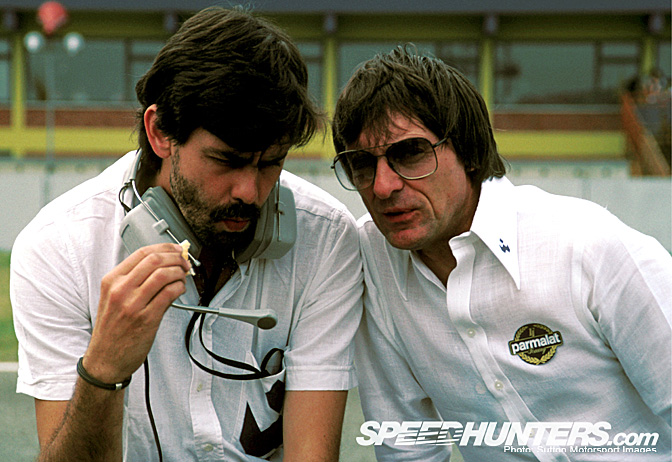

Bernard Charles Ecclestone………….OK most of you might have heard of him, he's that rich guy who effectively runs Formula One's business and has done for the past 35 years.
The Brits amongst you might also know him as the Bad Guy who has made the British Racing Drivers' Club jump through hoops just to keep a British Grand Prix on the calendar and at Silverstone. Those who have to toil in the outdated facility might take a different view.
Actually this only tells a small part of the story. At his core Bernie is, and always was a racer. During the 70's and 80's he owned the Brabham Grand Prix team. I am sure that back then, on any given day, you could have driven down Cox Lane, Chessington, past the factory and seen the Jolly Roger flying proud. They were the Jack Sparrows of the Formula One. Rock and Roll Racing, the Devil take the hindmost. In their pomp in the early 80s Bernie's Brabham crew were mavericks to a man.
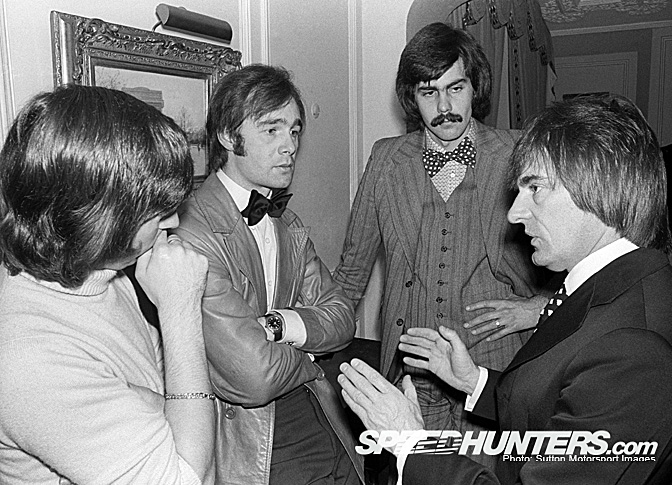
The story of how Bernie acquired his gang of outlaws in 1972 had its roots back in the 50's. BCE was a pretty handy F3 racer who also had enough brains to realise that he would not make it to the top. He did try and qualify for the 1958 Monaco Grand Prix, having purchased the assets of the Connaught F1 team, he did not make it nor did he ever attempt it again. Aside from his many other business interests he managed the careers of drivers Stuart Lewis-Evans and later, 1970 World Driver's Champion, Jochen Rindt.
Brabham was a constructor of racing cars founded in 1960 by Aussies, Ron Tauranac and Jack Brabham. Brabham had won two World titles in 1959 and 1960 and wanted to capitalise on the growing market for single seaters. They did so very successfully becoming the biggest constructor in the world. The company also went into F1, winning titles for Jack in 1966 and for Kiwi, Denny Hulme, in 1967. Brabham retired after the end of the 1970 season and Tauranac soldiered on 1971 but the financial risk of running a race team at the top level was not something he was comfortable with. He sold out to Ecclestone and soon left the company. He eventually set up the Ralt operation which dominated Formula Two and Three for many years.
For 1973 Bernie beefed up the team by bringing in two men who would take the backmarkers right back to the top of the tree. Gordon Murray, one of the greatest car designers of the past 25 years and Mike "Herbie" Blash, who would manage the process. Above, Murray and Blash listen to the Bolt explaining to a scribbler the exciting plans for 1974. Did we really dress like that back then? Oh dear.
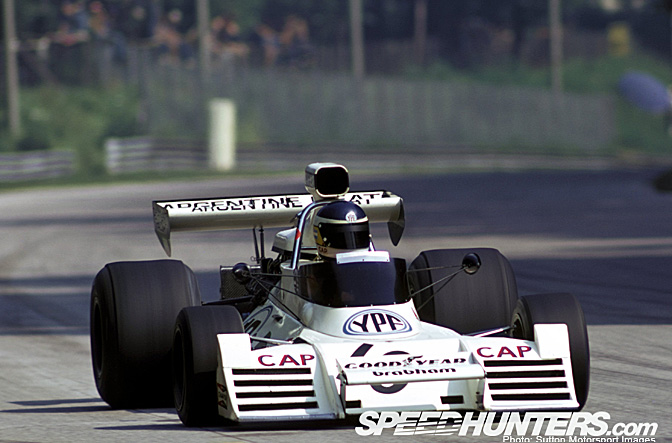
Murray's first design was the Brabham BT42 which was an improvement over the previous rag bag of cars and designs but even back then it took time to develop up a race winner.
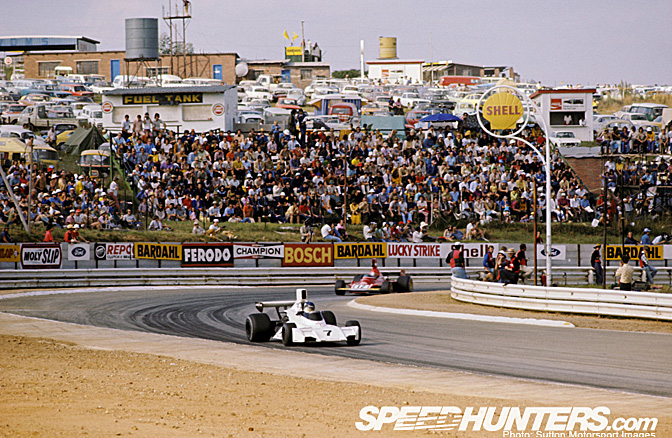
In 1974 the breakthrough came, Carlos Reutemann took full advantage of a top line Gordon Murray design, the BT44 to win three races. The first here at Kyalami.
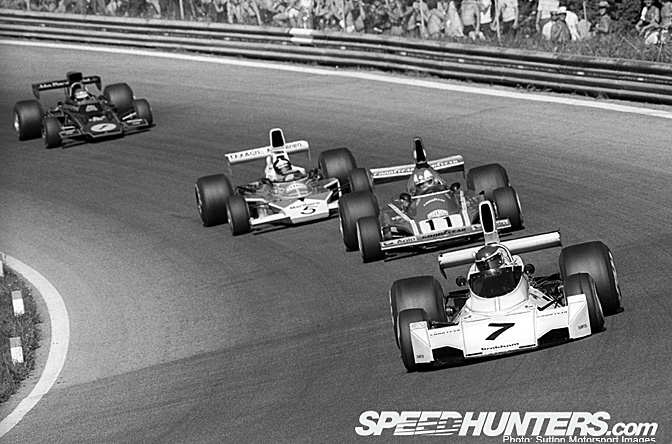
More success followed at Zeltweg and Watkins Glen and the team looked poised to take the fight to Ferrari and McLaren in 1975 for top honours.
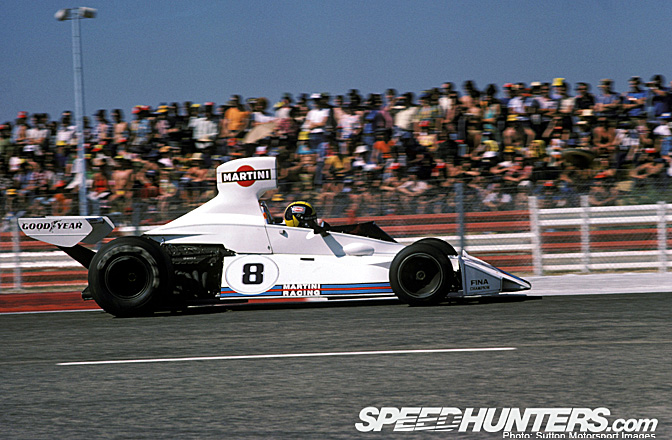
Despite a revised car and sponsorship from the Count Rossi's Martini drinks company Brabham did not live up to their potential. A win apiece for the two Carlos, Pace and Reutemann was not representative of the where the project should have gone. To be fair that year the combination of Niki Lauda and Luca de Montezemolo had inspired Ferrari to heights not seen in over a decade. For a change the Italians did live up to the their potential and the church bells rang out often in Maranello.
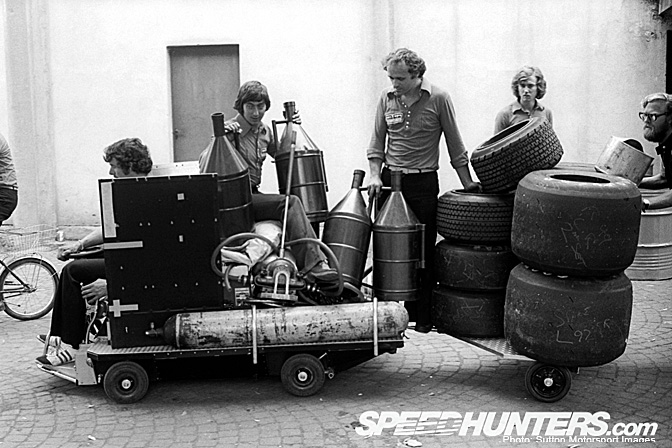
It was around this point that the story became personal. Living in Surrey back then, there were three Formula One teams that were local to me……….McLaren at Woking, Tyrrell at Ockham and Brabham at Chessington. It will surprise some of you to learn that I used to drink in a pub in Shepperton at that time. The King's Head was a bit of a motor racing mecca, the landlord, Dave Cameron, having a long racing background. Herbie Blash started also frequenting as did WSR supremo Dickie Bennetts. Soon we had a good number of Brabham employees downing pints such as Harvey Spencer, Robin Day. Roly Vincini, Jerry Bond, Charlie Whiting and a whole bunch of other faces I can still see but whose names have slipped into the ether. Maybe a few less beers might have helped.
So Brabham became our team, we were a proud bunch of piss-artists, cheering on our heroes. Herbie, Harvey and the rest would bring back tales from around the globe and during the next ten years we followed the exploits of Watson, Lauda, Piquet etc. rejoicing in their successes and commiserating in their defeats.
Until I joined the sport full time I did not appreciate the effort that Herbie would go through to to get us passes and tickets. With the responsibility of running a Grand Prix team he would always find a way to get us somewhere special during the races. He would also listen politely in the pub while we repeated the latest rubbish from Autosport or Motoring News, all the while knowing the real story. We have much to thank him for.
The team were always trying something different, here is the motorised pit trolley they built for the 1974 season.
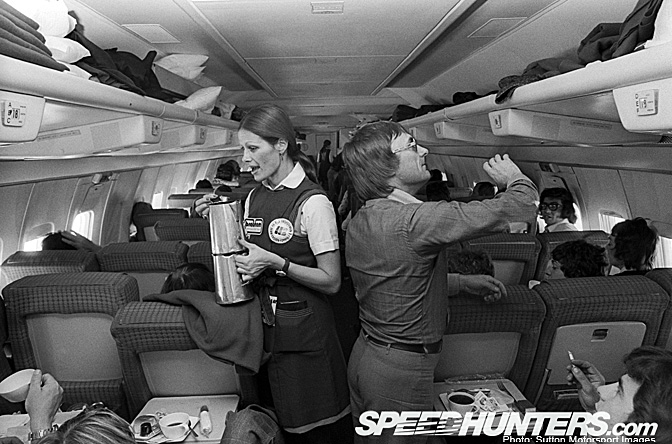
No private jets back then, Bernie sits in cattle class with the rest of the boys on the way to America. There seems a bit more room than exists now, progress don't ya know? And that appears to be my old mate, Alex, lighting up a tab, how did the plane not plunge into the waters? The Stewardess is sporting branding from both Brabham and Ensign, she would have earned her money on that flight.
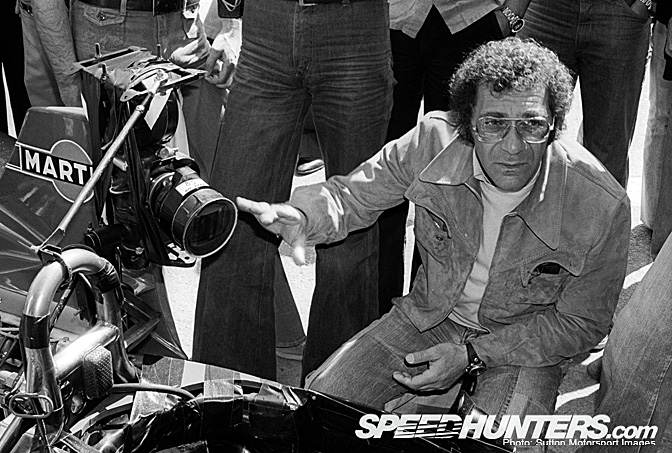
Hollywood came calling on Brabham during the making of the film, "Bobby Deerfield". Here Sydney Pollack, Director of the movie, oversees some in car footage. Stars like George Harrison and Rod Stewart were regular visitors to the Brabham pits.
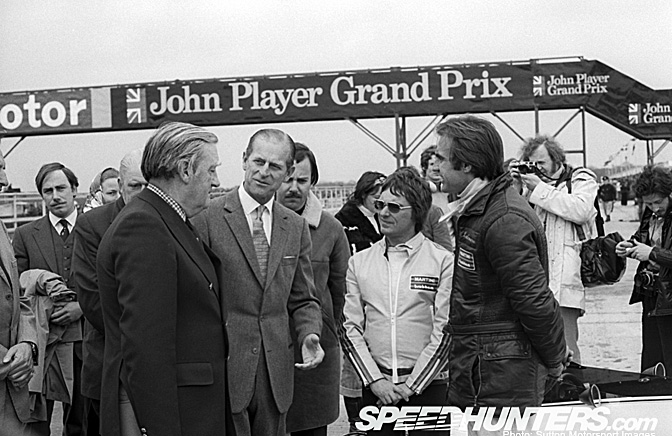
Even Royalty paid a visit to see Bernie and the Boys. HRH The Duke of Edinburgh swings by Silverstone back in 1975.
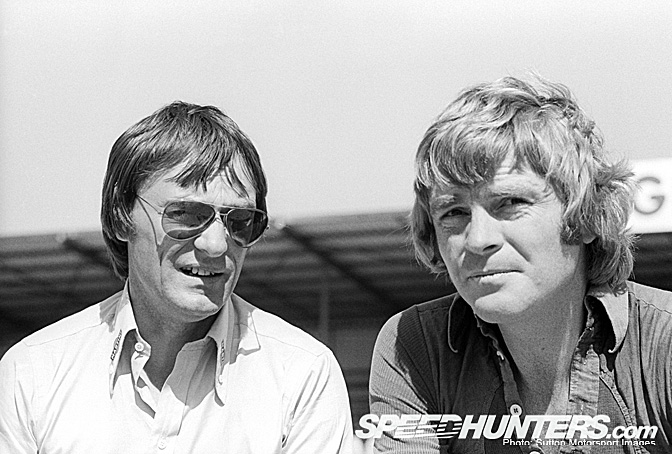
The exploits on the tracks were not the reason for the attention paid to Ecclestone. Since joining the F1 Circus he had become de facto leader of the pack. With March boss and ex-barrister, Max Mosely assisting, Bernie formed the Formula 1 Association. The aim was to create a package for the tracks and ultimately spectators, they would know in advance what they were going to see. The organisation would speak with one voice to the FIA on regulations.
Bernie could also see the potential revenue streams down the line if the Show was right. Sponsors, television and manufacturers all would come in time but it was the foundations that he laid in the mid-70s that allowed that to happen. He recognised that safety standards had to improve, drivers had to survive the initial impact of a crash and then should receive all the immediate assistance necessary to live. The manner of the deaths of drivers like Roger Williamson and Ronnie Peterson could not be tolerated, aside from the human cost, sponsors would simply walk away. Together with Professor Sid Watkins he ruthlessly pushed aside vested interests and other opposition to safety protocols, introducing measures that have saved the lives of many drivers right to this day. He brought a sense of organisation to the shambles that was race promotor's traditional approach. Common timetables for each event, control of passes and access would bring a sense of discipline to Grand Prix.
Ecclestone did not do all this with a sense of altruism, he could see the potential of the exciting, glamorous way of life and that with the right approach everyone connected with it could become rich, not least himself.
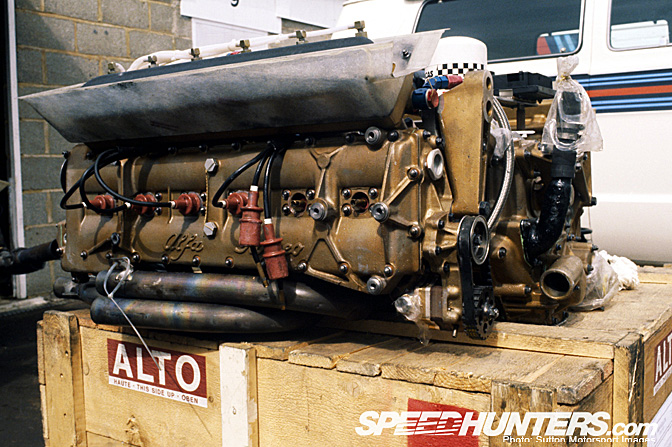
Back on track Brabham looked to get an unfair advantage by dropping the Cosworth DFV and getting Flat 12 power from Alfa Romeo. The deal meant free engines but there were hidden costs in terms of weight and fuel consumption that negated the extra horses.
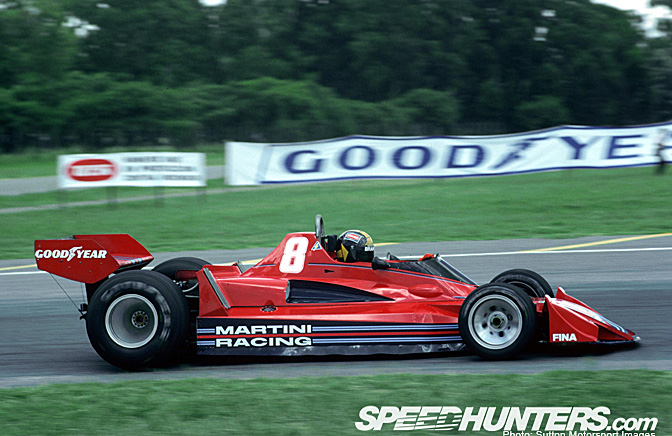
The size and layout of the Flat 12 Alfa motor was increasingly a problem as the era of ground effects came into F1. Poor reliability in 1976 and 1977 hampered progress as did the death of team leader Carlos Pace in a plane crash.
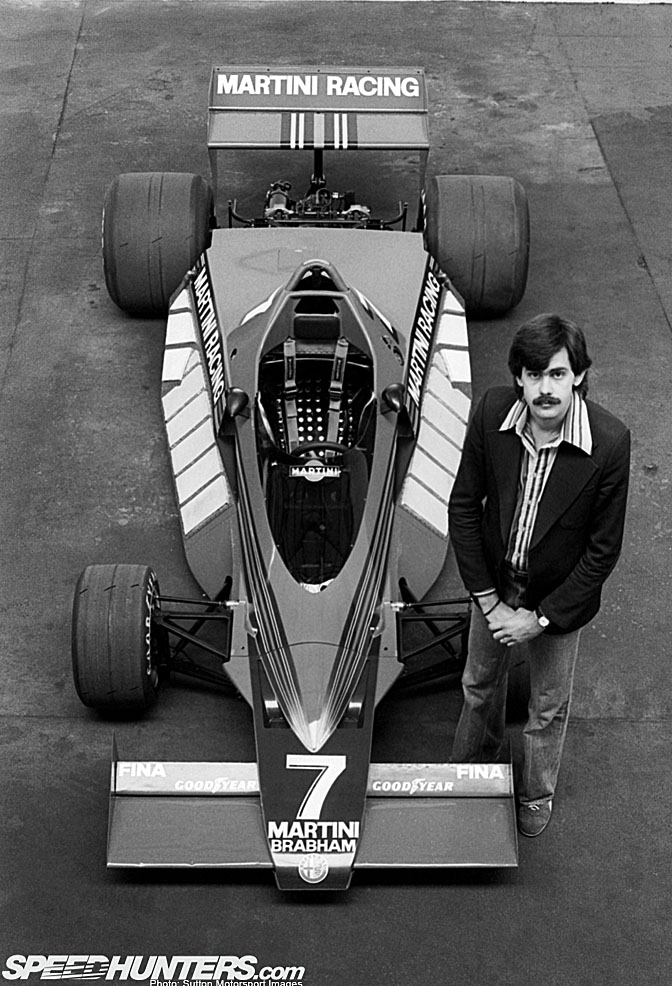
For 1978 there were wholescale changes to the Brabham team. The leading driver of the time, Niki Lauda was recruited and Gordon Murray produced the radical BT46. Uniquely the initial car featured heat exchangers instead of radiators.
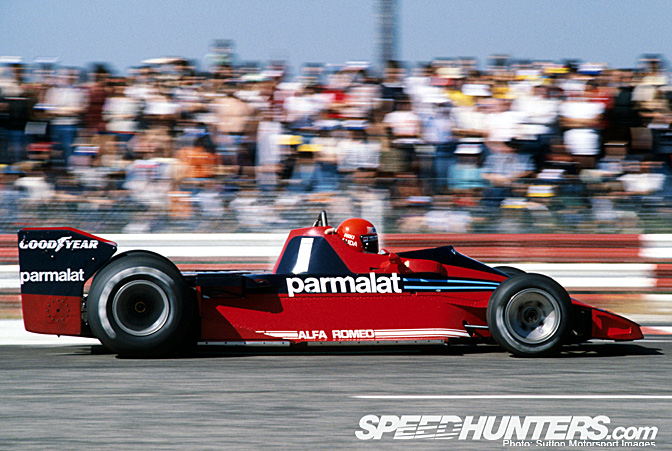
But in the real world they did not work so were replaced by conventional radiators after the first race. Reliability issues continued to plague the project with Lauda having a total of 11 engine failures alone.
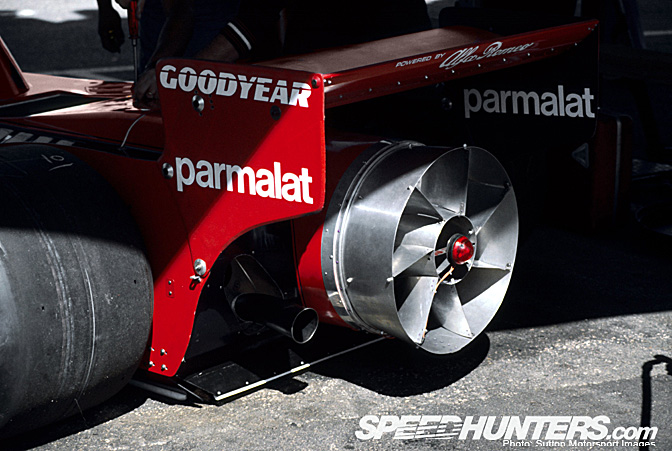
1978 was the year of the the pure ground effect Lotus 78 and it was evident to all that Lotus would dominate the season. All the designers up and down the pit lane scrambled to copy the new technology, well all except Gordon Murray. He looked to an earlier concept from the great Jim Hall and the Chaparral 2J which featured two fans at the rear to suck out the air from under the chassis, creating a pressure differential and thus downforce. Murray was forced down this route by the layout of the Flat 12 Alfa which precluded the creation of any significant venturi tunnels under the car.
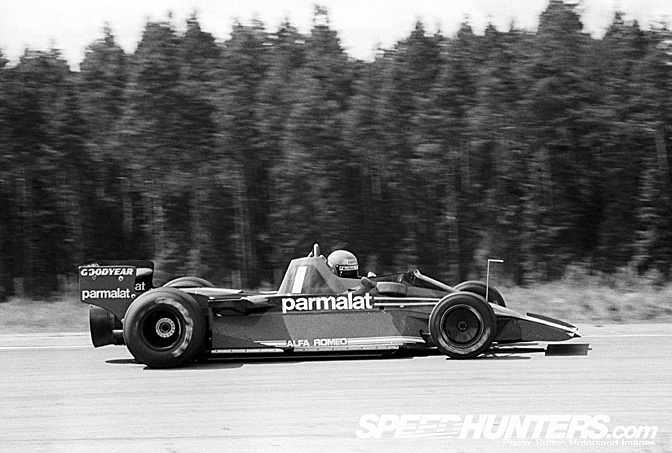
The BT46B appear at Anderstorp for the Swedish Grand Prix. It featured a large fan at the back of the car driven by the engine, thus the faster the engine revved the faster the fan went and the more air it blew, the greater the downforce.
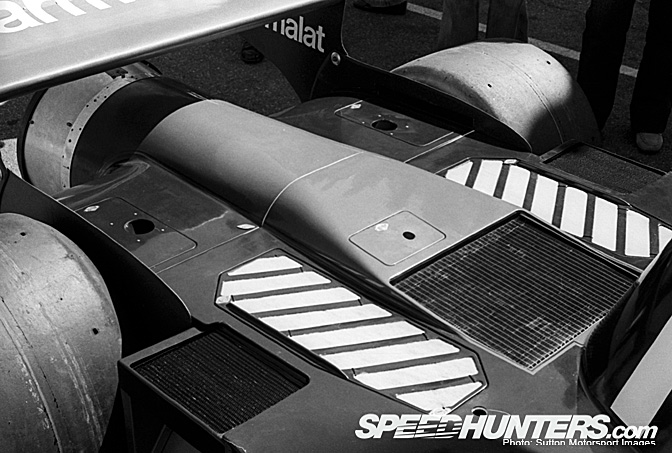
The whole thing was justified as a means of drawing air over the rear mounted surface radiators but no one was fooled. The engine bay was sealed and there were Lotus style sliding skirts underneath. It had re-written the design book.
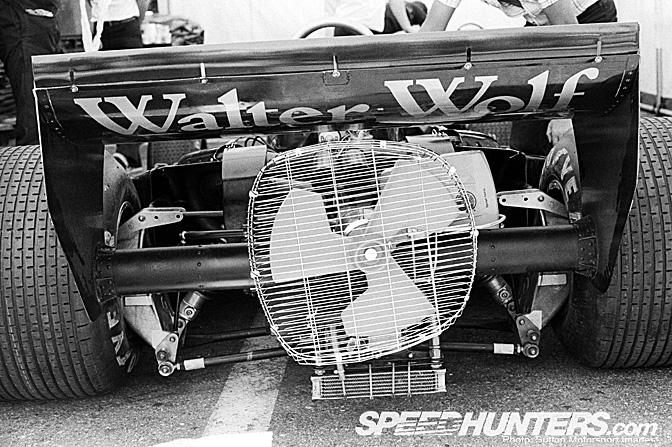
In the race Andretti in the Lotus retired so Lauda just drove off into the distance.
In the paddock there was mayhem and all the other teams protested the legality of the BT46B and the unity of the Formula One Constructors' Association was threatened. Ecclestone, with an eye on the long game, forsook the short term advantage of the Fan Car. The victory was allowed to stand but it never raced again.
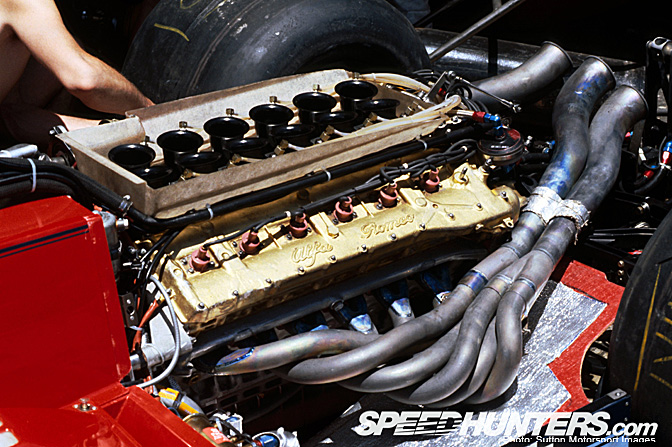
With the Lotus 78 rampant and the era of ground effect on hand, Brabham persuaded Alfa Romeo to build and produce a new V12 engine to allow them to match the advances in aerodynamics.
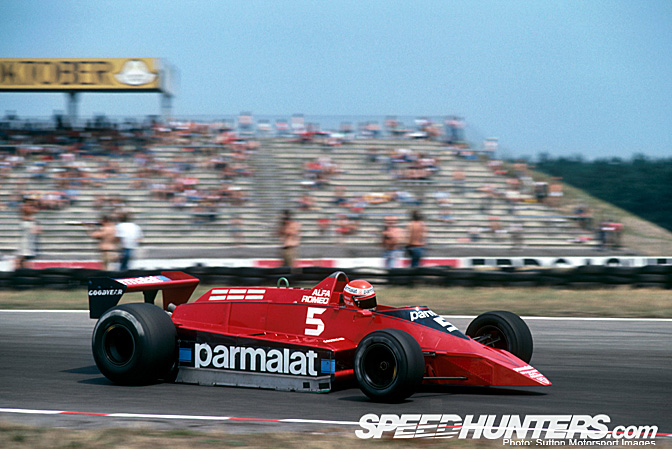
The new engine layout meant that Murray could pen a full ground effect car, the BT48. This was the first car to have a reliable carbon braking system, this development is used by virtually all racing cars today.
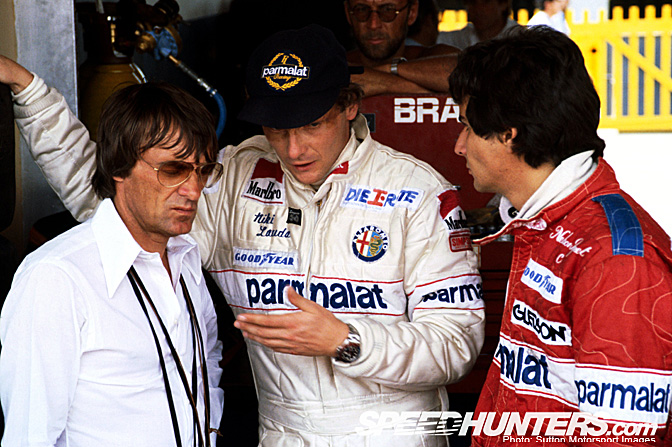
There were other changes to the team with future star Nelson Piquet being signed up and then dramatically Niki Lauda walked away from the Brabham and the Grand Prix arena during practice for the Canadian race.
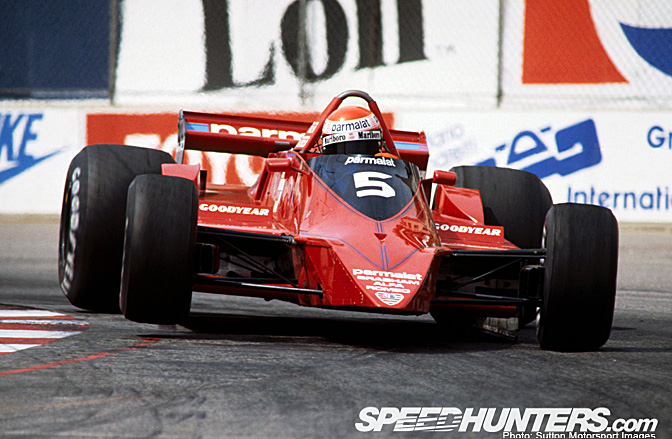
The relationship with Alfa Romeo was also at an end. Reliability issues still dogged the team and then Alfa decided to build their own chassis, DFV power was back.
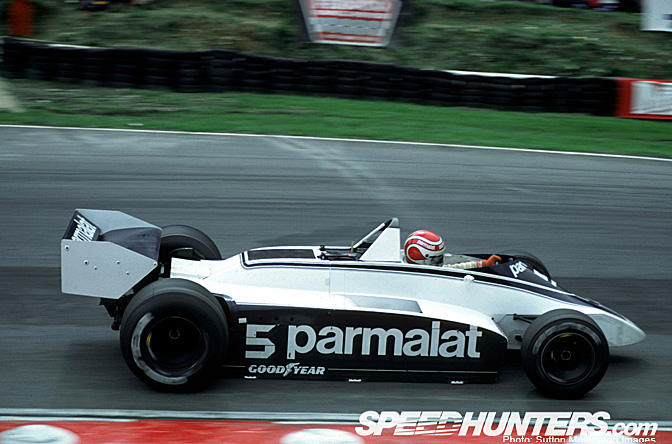
Murray's elegant and effective BT49 combined with Piquet's developing talent meant a Driver's Championship in 1981. Controversy followed this title as the team installed hydropneumatic suspension system to get round the FIA's minimum ride height rule of 6cms. This was measured in the pits but as soon as the Brabham was on track and at speed the system pushed the car back on to its skirts and voila ground effect was back but in a dangerous and unpleasant form. In a strange ruling the system was passed as legal by the FIA and everyone followed this practice. There were other whispers that Piquet's BT49 was seriously underweight on the track but nothing official was done. More piracy.
I recall seeing Nelson take the title in Las Vegas that year. I was in Herbie's flat in Shepperton, courtesy of the delightful Lynne. They had the right TV station and were within walking distance of the King's Head after chucking out time on the Sunday night. So a mob of us were invited to cheer on our team, not sure what the neighbours made of it, nor am I sure that I was particularly productive the next day at work.
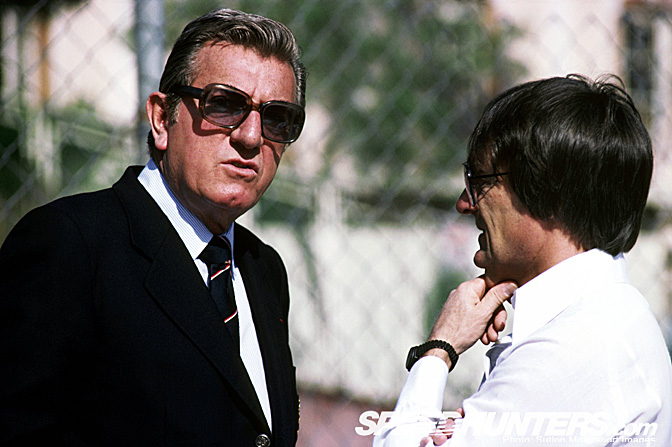
In parallel to the disputes on the track there was also an almighty row between the FIA in the form of the choleric President, Jean-Marie Balestre and FOCA, represented by Bernie and Max. After the FISA/FOCA war it was agreed that the FIA would set the rules and that FOCA would handle the commercial arrangements. This contract was known as the Concorde Agreement and it and and its successors have governed the conduct of Grand Prix racing since. Never has the maxim Follow the Money been so apt. Control of that aspect meant eventual control of everything. Ask Max about it this year. Bernie still controls the money.
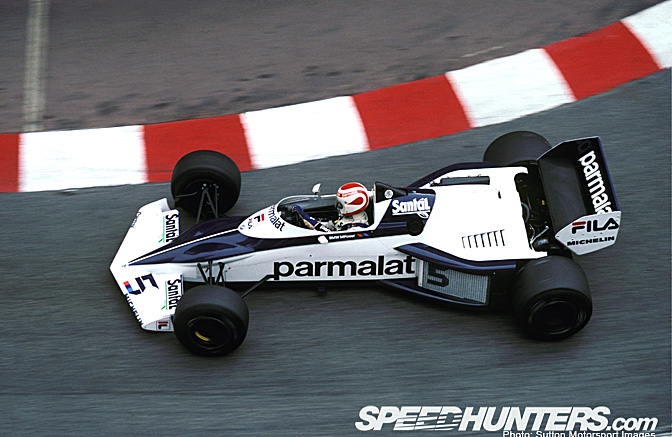
Money, ah yes, it was clear that the days of chucking a DFV into the back of a chassis and going racing with a view to win had passed. Brabham and Bernie formed an alliance with BMW. Piquet embraced the turbo powered car the BT52 to take the 1983 title.
This was the zenith for the Brabham team as they made a late charge for the Championship overtaking Alain Prost and Renault at Kyalami, the last race of the season. The car was arguably one of the most elegant designs in Grand Prix history allied to the powerful BMW M12/13 4 cylinder. Renault were mightily embarrassed to see their German rivals take honours after having pioneered the modern era of turbocharging in Formula One.
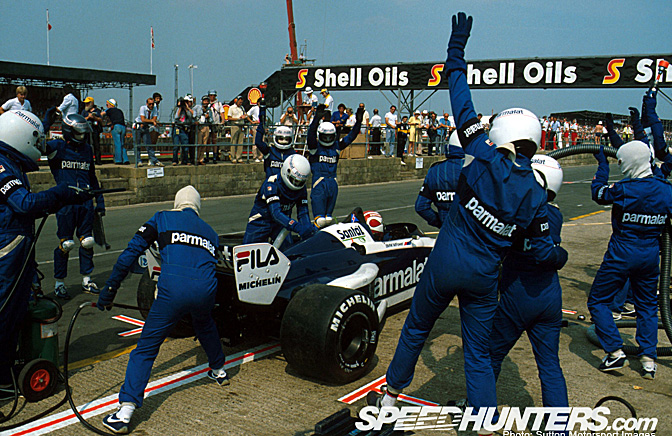
More innovation from Brabham. The BT52 was designed with pit stops in mind. The fuel tank was marginal for most races and the car featured pneumatic on board jacks and quick-change wheel fixings. Pit stops were coming to Formula One, now they are commonplace but back then they pushed the pit crew into the limelight, able to change the course of a race. Who else but Bernie's Boys? Why risk problems in the pits? Wheels sticking, fuel lines catching fire, that sort of thing.
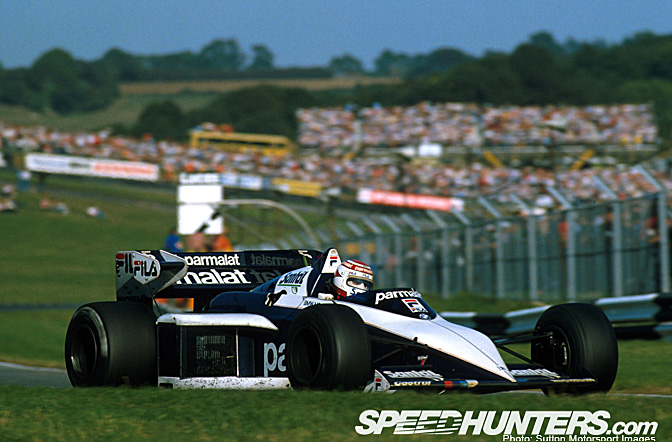
Simple really, the team had worked out it would be faster. Tanks were limited to 250 litres in 1983, refuelling meant that higher boost with an attendant rise in fuel consumption could be contemplated. Higher turbo boost led to more power and higher speeds, these 1.5 litre engines produced over 1000bhp. Lower weight meant softer, grippier tyres could handle the massive power output, a virtuous circle. Piquet driving like a real Champion produced the goods, so did the Pirates in the Pits. It was a great time to be a small part of all that. The celebrations back in the King's Head were prodigious.
Reliability problems blunted Brabham's efforts to retain their titles in 1984. In any case the game had moved on with a ban on refuelling eliminating one of the key cards in the 1983 triumph. Signing up with Pirelli in 1985 may have been financially sound in 1985 but the tyres were not truely competitive. Three wins in two seasons were poor reward for Piquet and so in his opinion was his retainer offer for 1986 from Bernie. He left Brabham for Williams.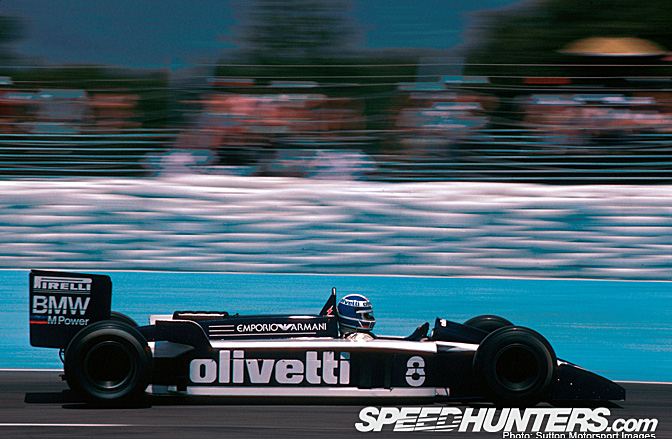
It was good timing as for Brabham 1986 was a disaster. Elio de Angelis was killed at Paul Ricard while testing. The radical low slung BT55 was simply not up to the job and the team only scored points once, a long fall from the heady days of 1983.
Gordon Murray left for McLaren at the conclusion of the season. The spell was broken.
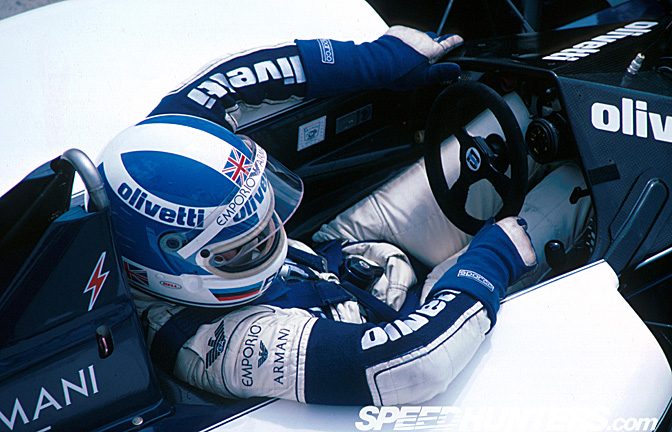
1987 was scarcely better. Ecclestone was pre-occupied with running FOCA and had lost interest in the team. BMW departed from Formula One back to sportscars. Bernie sold the team to a Swiss financier, Joachim Luhti, who was arrested on tax fraud charges in 1989.
Ownership of Brabham then passed to Middlebridge Racing but they too were involved in shady financial dealings with the notorious Landhurst Leasing company. In the middle of the 1992 season Middlebridge defaulted on their loans of £6 million from Landhurst Leasing. After a Serious Fraud Office investigation two directors of the finance company were jailed for accepting bribes for making further loans to the team. It was an ignominious end to the good ship Brabham.
Modern Formula One has no respect for past glories and Brabham joined such luminaries and former champions such as Team Lotus, Maserati, Alfa Romeo and Cooper Cars as now only existing as part of the heritage of Grand Prix racing.
For a few years the pirates down at Cox lane danced to a different beat to the rest of the grid, we could with more than a little of that spirit today.
Photos copyright and courtesy of Sutton Images www.sutton-images.com
John Brooks






mr ecclestone ... lol
Very interesting retrospective, thanks!
pic #2 should be captioned "corporate skulldugerers of the 70's in their tender years". lol
clasic car shots for sure!
Brilliant article as always Mr Brooks
On another note, isn't it a bit odd that F1 visited apartheid era South Africa?
Damn Damn Damn!!! absolutely love F1 in the 70's, nice feature John
now that is some great insider information! I look forward to many more F1 - related retrospectives.
Another classic Brooks. Thank god there's someone around to tell us youngsters how it was done back in the day.
Bernie and Max=antichrist
Excellent article Brooksie, Im sure a lot went on back then that cant possibly be published!
Epic!
This is why I come to speedhunters
F1
that look like Marc Gasol next to Bernie in the first pic. Fantastic article JB!
"Gee, Bernie, what do you want to do tonight?"
"The same thing we do every night Max... try to take over the world!"
Great article!
I suspect Bernie is in fact a Sith Lord...
Can't talk about Bernie and Hilter?
Article of the Year! More power to your arm Mr Brooks.
In the road-car world, vehicles that introduce revolutionary concepts normally spawn reams of imitators
In the road-car world, vehicles that introduce revolutionary concepts normally spawn reams of imitators
Oh yes, having worked there during the 80's I think the word 'Pirates' is right! Maybe I shouldn't say any more...
A wonderful overview of the formative years of Formula Racing!!
Leave it to Benrie!!... Well in the end that is in fact what happened. Bernie has it all.
Ciao
A wonderful overview of those ''formative'' years of Formula Racing!
Leave it to Bernie!
Thanks for this!
Thank you John for the mention! Great article, those were the days. ❤️❤️❤️